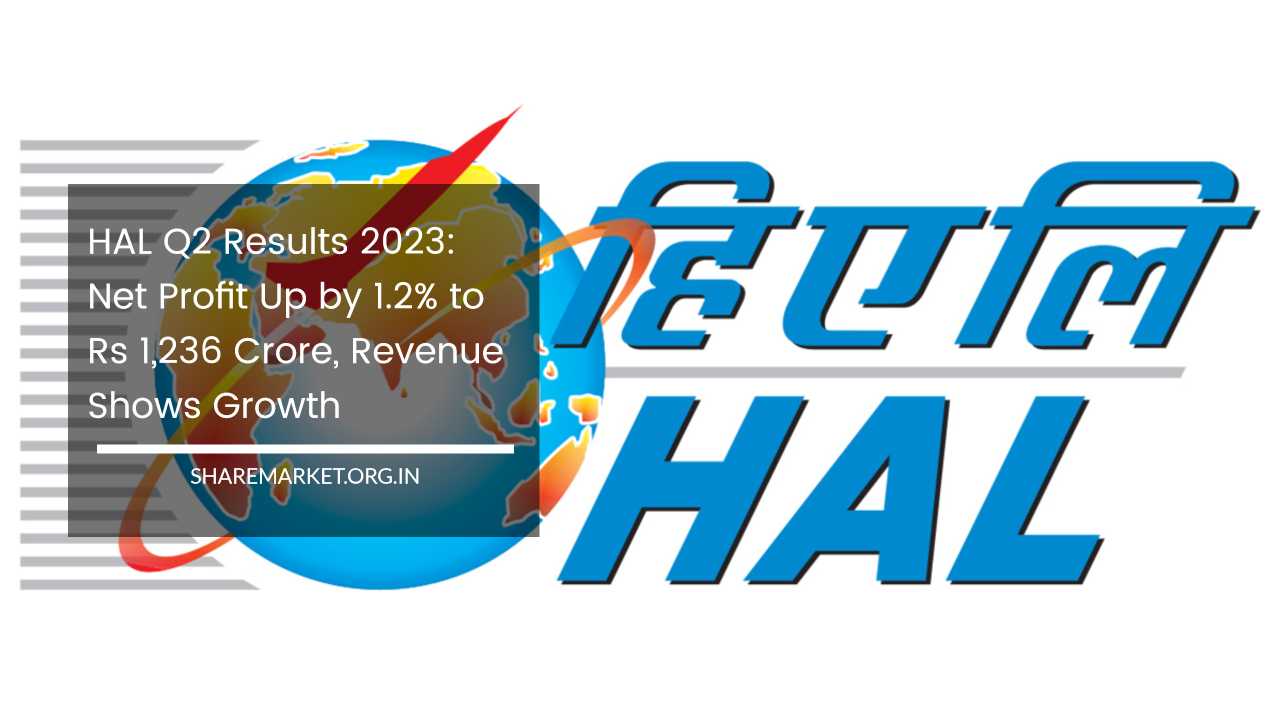HAL Q2 Results 2023: Net Profit Up by 1.2% to Rs 1,236 Crore, Revenue Shows Growth

HAL Q2 Results 2023
Hindustan Aeronautics Limited (HAL) is a renowned aerospace and defense company that is owned by the Government of India.
It plays a pivotal role in the development, design, manufacturing, and supply of a wide range of aviation and defense-related products, including aircraft, helicopters, avionics, and communication equipment.
With a rich history and a strong commitment to serving both military and civilian markets, HAL has been a key player in India’s aviation and defense sectors.
Recently, on November 10, HAL released its financial results for the second quarter of the fiscal year 2024. This announcement provided insight into the company’s performance and its strategic initiatives.
In this detailed expansion, we will delve deeper into HAL’s financial results, strategic collaborations, and the broader significance of its activities in the aviation and defense sectors.
Financial Performance
HAL’s financial results for the second quarter of FY24 revealed several noteworthy figures. The company reported a consolidated net profit of Rs 1236.67 crore for the quarter, reflecting a modest annual growth of 1.26 percent.
This positive trend in net profit is a positive sign for the company, indicating its ability to generate revenue and maintain profitability.
The revenue figures for this quarter were equally impressive. HAL reported a consolidated revenue of Rs 5635.7 crore, marking a robust year-on-year increase of 9.5 percent.
This growth in revenue showcases the company’s ability to expand its market presence and capture a larger share of the aviation and defense sectors.
However, it’s important to note that the company’s EBITDA (Earnings Before Interest, Taxes, Depreciation, and Amortization) experienced a decline of 5.8 percent year-on-year, reaching Rs 1527.7 crore in the second quarter of FY24.
This dip in EBITDA may warrant further analysis to identify the factors contributing to this decrease and assess the impact on HAL’s overall financial health.
One notable aspect of HAL’s financial results is the joint venture between HAL and HATSOFF Helicopter Training Pvt Ltd, which incurred a substantial loss of Rs 1,0166.16 lakh.
This loss had an adverse effect on the net worth of the company. Further investigation into the causes of this loss and the steps taken to mitigate it would provide valuable insights into HAL’s risk management strategies.
Another financial highlight is the repayment of an External Commercial Borrowing (ECB) loan capital of Rs 2,200 lakh.
This repayment demonstrates the company’s commitment to managing its debt obligations and maintaining financial stability.
It’s worth noting that the lending bank had classified ECB loans as non-performing assets, indicating the importance of addressing such issues promptly.
Strategic Collaborations
In addition to its financial results, HAL also made significant strides in strategic collaborations. One of the most noteworthy collaborations was the contract signing with Airbus for maintenance, repair, and overhaul (MRO) facilities for the A-320 aircraft. Airbus, a global leader in aircraft manufacturing, is set to provide HAL with the A320 family tool package.
This package includes specialized consultancy services to assist HAL in establishing its MRO facilities. Furthermore, the collaboration grants HAL access to AirbusWorld, a digital platform that provides extensive support, technical data, and training resources.
The significance of this collaboration cannot be overstated. It aligns with HAL’s mission to enhance self-reliance in the aircraft maintenance, repair, and overhaul industry in India.
The establishment of MRO facilities in Nashik, Maharashtra, will further bolster the country’s capabilities in this sector.
The fact that this initiative is awaiting approval from the Directorate General of Civil Aviation (DGCA) highlights the careful regulatory processes involved in such endeavors.
Market Performance
HAL’s market performance is a key indicator of its strength and influence in the aviation and defense sectors. As of 2.27 pm on the National Stock Exchange (NSE), HAL shares were trading at Rs 2036.25, reflecting a 0.27 percent increase.
This market performance suggests that investors have confidence in the company’s future prospects and are willing to invest in its shares.
Aerospace and Defense Expertise
To truly appreciate the significance of HAL’s activities, it’s essential to understand the company’s expertise and its role in India’s aviation and defense sectors.
HAL boasts a rich history of contributing to the country’s defense capabilities. The company has been involved in the design and production of various aircraft and helicopters, including the iconic HAL Tejas, Dhruv, and Chetak.
One of HAL’s key strengths lies in its ability to offer comprehensive solutions, ranging from aircraft design and manufacturing to avionics and communication equipment.
This wide array of offerings makes HAL a one-stop destination for the defense and aviation needs of the Indian government and various civilian organizations.
Strategic Importance
HAL’s activities extend beyond just being a commercial enterprise. It plays a pivotal role in strengthening India’s defense infrastructure.
As a government-owned entity, HAL is aligned with the national interest and contributes significantly to bolstering the country’s defense capabilities. Its products and services are not just for profit; they are instrumental in safeguarding the nation’s security.
Furthermore, HAL’s collaborations with international giants like Airbus highlight its commitment to staying at the forefront of technology and innovation.
The partnership with Airbus for MRO facilities is a testament to HAL’s dedication to enhancing its capabilities and staying competitive on a global scale.
Socio-Economic Impact
The activities of HAL have a substantial socio-economic impact. The company generates employment opportunities for a diverse range of skilled professionals, including engineers, technicians, and support staff.
This, in turn, contributes to the economic development of the regions where HAL operates. Its presence in Nashik, Maharashtra, where the MRO facility is set to be established, is expected to create jobs and stimulate economic growth in the area.
The socio-economic impact of HAL extends to its supply chain as well. The company sources materials and components from various suppliers, which can stimulate economic activity in those regions.
By partnering with local suppliers, HAL contributes to the growth of small and medium-sized enterprises, fostering a more robust industrial ecosystem.
Technological Advancements
HAL is at the forefront of technological advancements in the aerospace and defense sectors. It invests in research and development to enhance its product offerings and keep pace with global standards.
The collaboration with Airbus for MRO facilities and access to AirbusWorld’s digital platform is a testament to HAL’s commitment to adopting cutting-edge technology.
By integrating digital tools and platforms, HAL can streamline its operations, improve efficiency, and provide better services to its customers.
This digital transformation is essential in an era where precision, speed, and accuracy are paramount in aviation and defense.
Global Perspective
HAL’s activities are not limited to the Indian market. It exports its products and services to various countries, thereby contributing to India’s foreign exchange earnings.
This global perspective positions HAL as a key player in the international defense and aviation arena.
Through collaborations, joint ventures, and exports, HAL not only enhances its revenue but also strengthens diplomatic ties with other nations.
Its products and services are often sought after by countries looking to bolster their defense capabilities, and this international demand underscores the quality and reliability of HAL’s offerings.
Future Outlook
HAL’s financial results, strategic collaborations, market performance, aerospace and defense expertise, strategic importance, socio-economic impact, technological advancements, and global perspective collectively paint a promising future outlook for the company.
The positive growth in net profit and revenue, despite some challenges, showcases the company’s resilience and ability to adapt to changing market conditions.
HAL’s ability to navigate challenges, such as the decline in EBITDA and losses incurred in joint ventures, demonstrates its agility in managing risks and adapting strategies to maintain profitability.
The repayment of ECB loans, though classified as non-performing assets, underlines HAL’s commitment to prudent financial management.
The strategic collaboration with Airbus for MRO facilities is a significant step towards enhancing the country’s self-reliance in aviation services.
The expected launch of the MRO facility in Nashik, Maharashtra, pending DGCA approval, indicates HAL’s commitment to technological advancement and adherence to regulatory standards.
In terms of market performance, the incremental increase in HAL’s shares on the NSE showcases investor confidence in the company’s trajectory. This vote of confidence in HAL’s future prospects signifies a positive market sentiment and potential for growth.
The company’s expertise in aerospace and defense, with a portfolio that ranges from designing and manufacturing aircraft to providing avionics and communication equipment, places HAL at the forefront of India’s defense infrastructure.
Furthermore, HAL’s strategic importance in contributing to national defense capabilities cannot be overstated. As a government-owned entity, its products and services are not solely driven by profit motives but are integral to securing the nation’s interests.
The socio-economic impact of HAL’s activities is multifaceted. It generates employment, stimulates economic growth in regions where it operates, and fosters a network of suppliers, thereby contributing to a robust industrial ecosystem.
Technological advancements, exemplified by the collaboration with Airbus and the integration of digital platforms, showcase HAL’s commitment to staying technologically relevant and maintaining a competitive edge in the global market.
From a global perspective, HAL’s export of products and services not only augments its revenue but also contributes to India’s global standing in the defense and aviation sectors. This international demand underscores the quality and reliability of HAL’s offerings.
The future outlook for HAL appears promising. With its resilience, commitment to technological advancements, and strategic collaborations, the company is well-positioned to address challenges, capitalize on opportunities, and remain a key player in India’s aerospace and defense sectors.
However, it’s essential for HAL to address the decline in EBITDA and losses incurred in joint ventures. A thorough analysis and strategic interventions may be necessary to mitigate these challenges and sustain growth.
Moreover, maintaining a vigilant approach to financial management and risk mitigation will be critical in ensuring continued profitability.
Furthermore, while the collaboration with Airbus for MRO facilities is a significant leap forward, ensuring the smooth establishment and functioning of these facilities will be crucial. Collaboration with global leaders needs meticulous execution and adherence to the highest industry standards.
The regulatory clearance from DGCA for the MRO facility in Nashik, Maharashtra, is another milestone to watch. The timely approval and subsequent launch will be a pivotal moment, indicating HAL’s capacity for innovation and adherence to stringent regulatory requirements.
In conclusion, HAL’s recent financial results, strategic collaborations, market performance, expertise, strategic importance, socio-economic impact, technological advancements, and global perspective collectively position the company for a promising future.
The company’s commitment to innovation, national security, and economic development highlights its pivotal role in India’s aerospace and defense sectors.
Through strategic interventions and a commitment to excellence, HAL is poised to continue its legacy as a significant contributor to India’s aviation and defense industries.

















